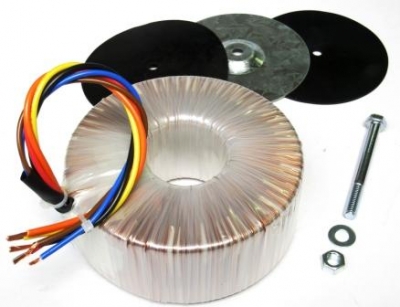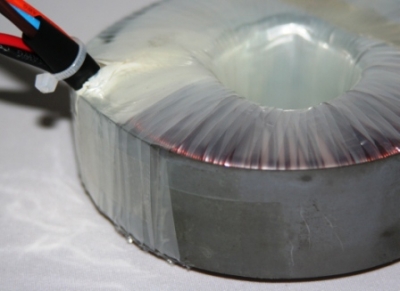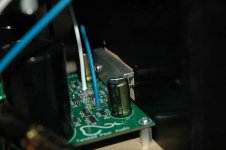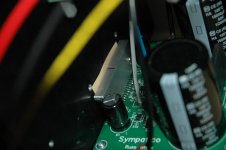TTSA0500 - Transformer AUDIO TSA500VA - voltage to 50 V
http://sklep.toroidy.pl/en_US/p/TTSA0500-Transformer-AUDIO-TSA500VA-voltage-to-50-V/319 ~ $74
2 x 26V
We need to buy a mounting pad + screw!
http://sklep.toroidy.pl/en_US/p/TTSA0500-Transformer-AUDIO-TSA500VA-voltage-to-50-V/319 ~ $74
2 x 26V
An externally hosted image should be here but it was not working when we last tested it.
We need to buy a mounting pad + screw!
Last edited:
Plitron
The best?
500VA Power Transformer Output: 2 X 25VAC @ 10.00A ~ $126
http://shop.plitron.com/shopexd.asp?id=202#
The best?
500VA Power Transformer Output: 2 X 25VAC @ 10.00A ~ $126
http://shop.plitron.com/shopexd.asp?id=202#
500VA Power Transformer: Input:115/230VAC 50/60Hz; Output: 2 X 25VAC @ 10.00A; 4%Regulation; Potted Center
An externally hosted image should be here but it was not working when we last tested it.
Last edited:
Airlink Transformers (UK)
Chassis mounting toroidal transformers
Standard Range Toroidal Transformer
Product Description:500VA 230v to 2x25v ~ $63
-> Standard Range Toroidal Transformers: CM0500225: 500VA 230v to 2x25v

with NM02 EMI/RFI Shield ~$10.5

Chassis mounting toroidal transformers
Standard Range Toroidal Transformer
Product Description:500VA 230v to 2x25v ~ $63
-> Standard Range Toroidal Transformers: CM0500225: 500VA 230v to 2x25v

with NM02 EMI/RFI Shield ~$10.5
GOSS Steel band wound around the finished transformer to reduce electromagnetic & Radiofrequency interference

Last edited:
G.O.S.S. Band (Grain Oriented Silicon Steel Band)
G.O.S.S. Band - Custom Designed Toroidal Transformers from Nuvotem Talema
G.O.S.S. Band - Custom Designed Toroidal Transformers from Nuvotem Talema
An externally hosted image should be here but it was not working when we last tested it.
A G.O.S.S. Band (Grain Oriented Silicon Steel Band) is a method of reducing the radiated magnetic field from a transformer, and is used on transformers for domestic and professional Audio and Audio Visual equipment.
Even though a toroidal transformer exhibits much lower levels of "Stray Field" or radiated magnetic field when compared to conventional transformers (Click here for more information) these levels may be reduced even further by attaching a screen to the outer circumference of the transformer.
From europeans, the polish Toroidy is a very good option.
-> http://sklep.toroidy.pl/en_US/p/TTSA0500-Transformer-AUDIO-TSA500VA-voltage-to-50-V/319
-> http://sklep.toroidy.pl/en_US/p/TTSA0500-Transformer-AUDIO-TSA500VA-voltage-to-50-V/319
Is 500VA too much?Audio grade transformer is dedicated for use in power amplifiers and other high-end audio devices. In audio grade, noiseless transformer price. You'll get transformer wound on high inductive, selected and measured core. Core and all the windings will are impregnated. Transformer will also has electric and electromagnetic shields, epoxy filled interior and mounting pads in price.
Available output voltages:
10V, 2x10V, 11V, 2x11V, 12V, 2x12V, 13V, 2x13V, 14V, 2x14V, 15V, 2x15V, 16V, 2x16V, 17V, 2x17V, 18V, 2x18V, 19V, 2x19V, 20V, 2x20V, 21V, 2x21V, 22V, 2x2V, 23V, 2x23V, 24V, 2x24V, 25V, 2x25V, 26V, 2x26V, 27V, 2x27V, 28V, 2x28V, 29V, 2x29V, 30V, 2x30V, 31V, 2x31V, 32V, 2x32V, 33V, 2x33V, 34V, 2x34V, 35V, 2x35V, 36V, 2x36V, 37V, 2x37V, 38V, 2x38V, 39V, 2x39V, 40V, 2x40V, 41V, 2x41V, 42V, 2x42V, 43V, 2x43V, 44V, 2x44V, 45V, 2x45V, 46V, 2x46V, 47V, 2x47V, 48V, 2x48V, 49V, 2x49V, 50V, 2x50V
Too much for what? A stereo amp? A quad amp? Bridged amp?
Did you look at the Taming the LM3886 - Power Supply Design page? Which VA rating did the Excel sheet come up with for your design conditions?
~Tom
Did you look at the Taming the LM3886 - Power Supply Design page? Which VA rating did the Excel sheet come up with for your design conditions?
~Tom
Conclusion: An LM3886 running on a ±25 V supply, delivering the largest possible undistorted sine wave into a 4 Ω load will need a 140 VA transformer. For a stereo amplifier a 280 VA transformer should be used. I would round up to the nearest available standard size, which, typically, is 300 VA.
Supply Voltage Output Drop-out Voltage Load Impedance Quiescent Current Crest Factor (dB) Crest Factor Peak Output Power RMS Output Power Peak Output Voltage Supply Power (RMS) Dissipated Power (RMS) Power Transformer VA Rating
26 2,5 4 0,05 3 2,00 138,06 69,20 23,53 99,96 30,76 149,94
TTSA0300 - Transformer AUDIO TSA300VA - voltage to 50V 2x26V
-> http://sklep.toroidy.pl/en_US/p/TTSA0300-Transformer-AUDIO-TSA300VA-voltage-to-50V-/317 ~$54
and
M003 - Mounting pad M90
-> http://sklep.toroidy.pl/en_US/p/M003-Mounting-pad-M90/93

and a large screw in a ironmongery!
-> http://sklep.toroidy.pl/en_US/p/TTSA0300-Transformer-AUDIO-TSA300VA-voltage-to-50V-/317 ~$54
and
M003 - Mounting pad M90
-> http://sklep.toroidy.pl/en_US/p/M003-Mounting-pad-M90/93

Toroidal transformer mounting pad. Diameter 90mm.
Package inluded: 1 metal pad + 2 neoprene rubber pads.
Suggested for 300VA to 400VA toroidal transformers.
and a large screw in a ironmongery!
Maybe another option?
55173-P1S2 TALEMA - Transformer: toroidal | TME - Electronic components €33
They sell the mounting kit:
http://www.tme.eu/en/details/tsth-md/coilformers-and-accessories/indel/#
55173-P1S2 TALEMA - Transformer: toroidal | TME - Electronic components €33
They sell the mounting kit:
http://www.tme.eu/en/details/tsth-md/coilformers-and-accessories/indel/#
Last edited:
Supply Voltage Output Drop-out Voltage Load Impedance Quiescent Current Crest Factor (dB) Crest Factor Peak Output Power RMS Output Power Peak Output Voltage Supply Power (RMS) Dissipated Power (RMS) Power Transformer VA Rating
26 2,5 4 0,05 3 2,00 138,06 69,20 23,53 99,96 30,76 149,94
The power supply voltage needs to be set to 35 V if you plan to operate with +/-35 V rails.
The numbers calculated will be per channel. Multiply by the number of channels for the final VA rating of the transformer.
I suggest reading up on how full-wave rectifiers work as you seem to be a bit confused by the RMS voltage of the transformer versus the rectified voltage on the output of the power supply. Wikipedia comes to the rescue:http://en.wikipedia.org/wiki/Rectifier
~Tom
Last edited:
35 2,5 4 0,05 3 2,00 264,06 132,34 32,54 184,75 52,41 277,13
277 x 2 => 600 VA
And Dissipated Power (RMS) 52,41 for channel
I think 600 VA is a very high value for only 60W/8Ohms - 120W/4Ohms.
Usually I listen vinyl rips (classical) with DR 11 - 15 => 14
35 2,5 4 0,05 14 25,12 264,06 10,51 9,17 54,58 44,07 81,88
200 VA
My initial election was 230 VA.
277 x 2 => 600 VA
And Dissipated Power (RMS) 52,41 for channel
I think 600 VA is a very high value for only 60W/8Ohms - 120W/4Ohms.
Usually I listen vinyl rips (classical) with DR 11 - 15 => 14
35 2,5 4 0,05 14 25,12 264,06 10,51 9,17 54,58 44,07 81,88
200 VA
My initial election was 230 VA.
Last edited:
277 x 2 => 600 VA
I think 600 VA is a very high value for only 60W/8Ohms - 120W/4Ohms.
277 VA per channel is needed if you want to reproduce a sine wave at the highest possible output voltage swing. You may find that excessive, but physics and math don't lie...
Now, most of us listen to music rather than sine waves, hence, my exercise with the crest factor both on my website and in the spreadsheet.
Usually I listen vinyl rips (classical) with DR 11 - 15 => 14
200 VA
My initial election was 230 VA.[/QUOTE]
There you go! You have now made an informed design decision. Congratulations!
@Bill: +1 on the real estate reduction. I don't need to see images of transformers and mounting hardware. Specs and website links are sufficient.
~Tom
85ºC or 105 ºC
Image: http://www.neurochrome.com/audio/wp-content/uploads/2014/12/Power-86_Assembled50V.jpg
22000 mF and 85ºC x 2
And others electrolytic capacitors are of 85ºC. Why not 105 ºC? Price?
Image: http://www.neurochrome.com/audio/wp-content/uploads/2014/12/Power-86_Assembled50V.jpg
22000 mF and 85ºC x 2
And others electrolytic capacitors are of 85ºC. Why not 105 ºC? Price?
There isn't that much choice in 22000uF/50V capacitors. 
Some choices for clips that press the LM4780 against the heatsink over a reasonable large area:
Mouser part# 532-MAXCLIP08G
And for the old continent Conrad.com stocks part# 188074 - 62
Some choices for clips that press the LM4780 against the heatsink over a reasonable large area:
Mouser part# 532-MAXCLIP08G
An externally hosted image should be here but it was not working when we last tested it.
And for the old continent Conrad.com stocks part# 188074 - 62
An externally hosted image should be here but it was not working when we last tested it.
And others electrolytic capacitors are of 85ºC. Why not 105 ºC? Price?
Price, availability, size, specifications are all considered when I choose a capacitor. Depending on the application, any of these factors may trump the others. I try to select 105 ºC electrolytics when I can, mostly because some people perceive them as higher quality, but also because it buys some peace of mind. In reality, the temperature rating of the cap matters little as the caps will operate near room temperature for the vast majority of their lifespan. I do choose capacitors which are appropriate for the application, so for the supply caps, for example, I do make sure that they're rated for high ripple current.
~Tom
Some choices for clips that press the LM4780 against the heatsink over a reasonable large area:
Mouser part# 532-MAXCLIP08G
Nice find! Thanks.
~Tom
TPA Sympatico kit comes with a thick aluminum extrusion, cut to length and with screw thru holes drilled. It does not appear to be a commercial product intended as a heatsink clamp, but a custom part from a simple standard extrusion. It works great with a film insulator. Note the "L" which increases the stiffness to keep it flat when the screws tighten.
Attachments
- Home
- Amplifiers
- Chip Amps
- Modulus-86 build thread

